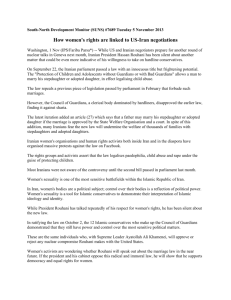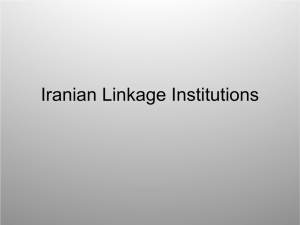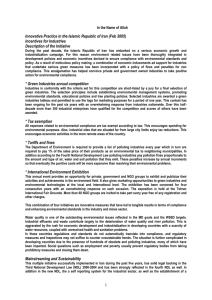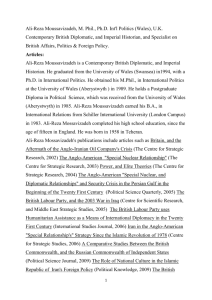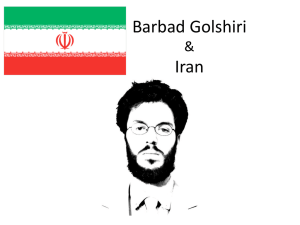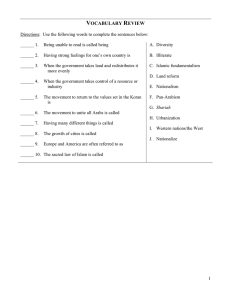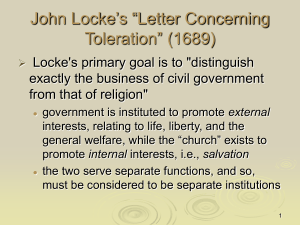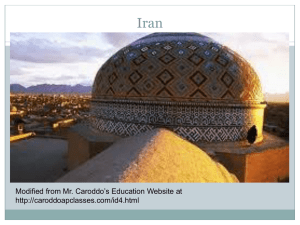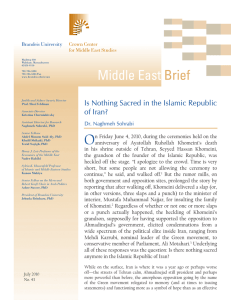Iran: Citizens, Society, and State
advertisement
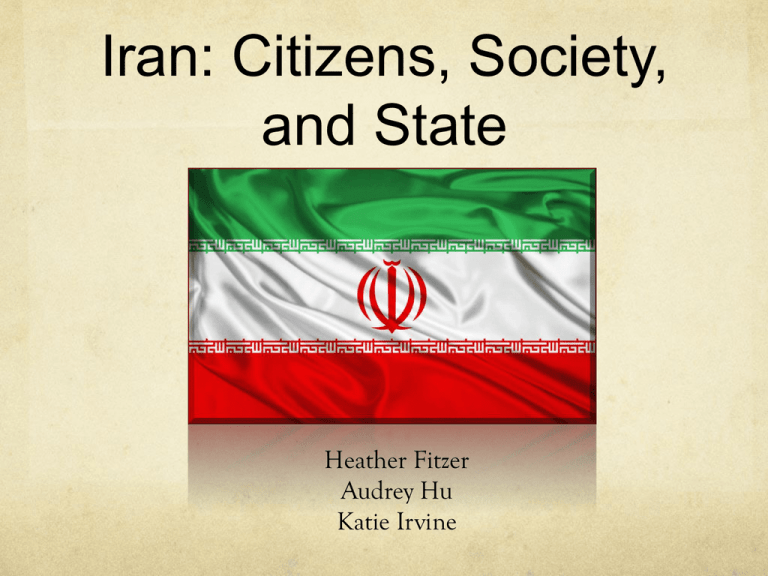
Iran: Citizens, Society, and State Heather Fitzer Audrey Hu Katie Irvine Cleavages in Iran I. Religion II. Ethnicity III. Social class IV. Reformers vs. Conservatives V. Pragmatic Conservatives vs. Radical Clerics Religion • 89% Shi’a Muslims • 10% Sunni Muslims • Other 1% consists of Jews, Christians, Zoroastrian, and Bahai • Constitution recognizes minorities and guarantees rights Ethnicity • • • • • • 51% Persian 24% Azeri 8% Gilaki and Mazandarani, 7% Kurds, and 3% Arabi Remaining percentage are a combinations of different groups Constitution requires minority languages to be taught in schools but not all schools follow this Minorities are often denied government jobs Social Class • Peasants and lower middle class support the regime • Middle and upper-middle are largely secularized • Middle-class has not done well economically since the founding of the Republic and have become discontent with the regime Reformers vs. Conservatives • Existed since the founding of the Republic • Debate about theocracy vs. democracy • Conservatives want to keep the regime under control of clerics and Sharia law • Reformers want to secularize and democratize Pragmatic Conservatives vs. Radical Clerics • Divisions among the clergy that have led to disagreements in policymaking • Pragmatic conservatives favor liberal economic policies • Conservatives say that private property and economic inequality are protected under Islamic law Iran’s Civil Society: Although not fully restored under the current regime, it is alive and well. Civil Society under Muhammad Khatami 1997-2005 • Tehran Spring - political and global liberalization - more open economy Civil Society under Mahmoud Ahmadinejad 2005 - now • Decrease in civil society • Arrest of prominent scholars including Esfandiari and Panahi Arrested Scholars • Haleh Esfandiari • Jafar Panahi Arrests against Western Dress Under the Ahmadinejad regime Political Participation Although the Constitution of 1979 guarantees civil liberties, the Islamic Republic has never followed through with such rights. • Newspapers, labor unions, private organizations, and political parties were banned from the start. • Many political reformers have fled the country, or been executed • Protests and Demonstrations 1999: Many protests erupted in universities across the nation when the government shut down a reformist newspaper 2002: Similar demonstrations broke out among students when the courts ruled a death sentence for a reformist academic 2003: Mass student protests over privatization of the university system escalated Protestors called for the overthrow and death of Iran’s religious and political leaders. Factory workers tend to participate in many rallies against the government because of high unemployment rates, low wages, and unsatisfactory labor laws 2005: Ahmadinejad renewed strict laws on protests and demonstrations with severe punishments. The Green Movement The Green Movement: Biggest upheaval since 1979 Revolution, Ahmadinejad was elected president again in 2009. Won with 63% of the vote against Mir Hossein Mousavi • Opposition wanted election to be annulled and people from both sides raided the streets • Lasted 7 days and many were arrested • Government sent tens of thousands of Revolutionary Guards and voluntary militiamen (basij) and the state controlled media said 20 were killed. • Eary 2011, the Green Movement, freedom seeking protestors marched led my Mousavi • Tear gas and clubs were used by police and the basij militiamen to subdue the crowds • Obama called on Iran to let people express their civil liberties and opinions Women One of the most frequently stated criticisms of Iran from westerners is the nation’s treatment of women. Women in Iran • Cultural traditions are seen as signs of oppression more so by westerners than by Iranian women themselves. • Traditionally, Iranian women have worn veils (predating the birth of Islam), stayed home, and have received little education or opportunity outside of home. • As the 20th century rolled around, women have had a better access to education. • More than half of college students today are women. • Education has caused women to harbor resentment toward the Islamic/Sharia regime • They expect better job opportunities and more political rights than they are granted. • The Islamic Republic calls its policy toward women “equality with difference”: the divorce and custody laws now follow Islamic standards that favor males. • Women must wear scarves and long coats in public, and they cannot leave the country without the consent of a male relative. • Women now constitute 33% of the labor force. • Only 2.8% of women are represented in the Lower House of the National Assembly.
